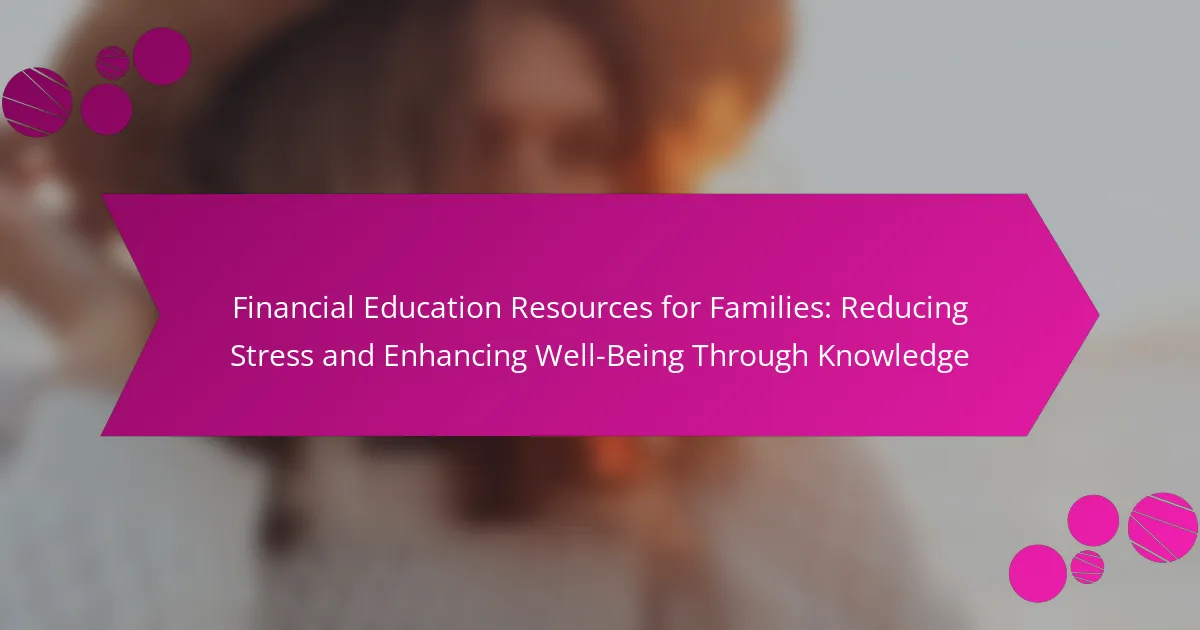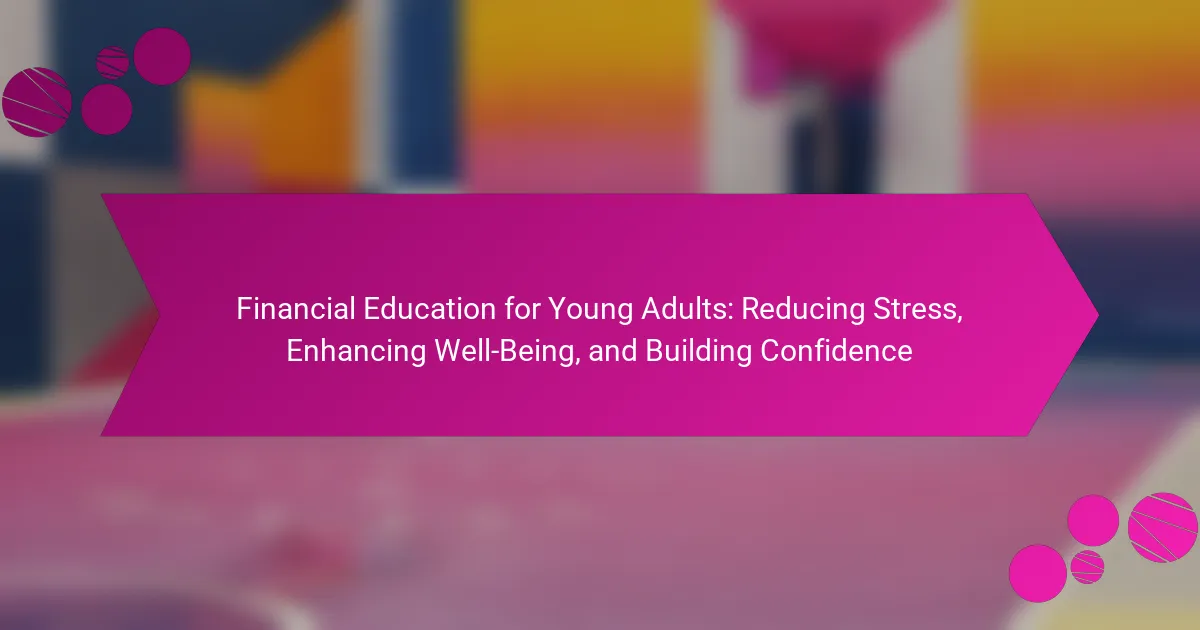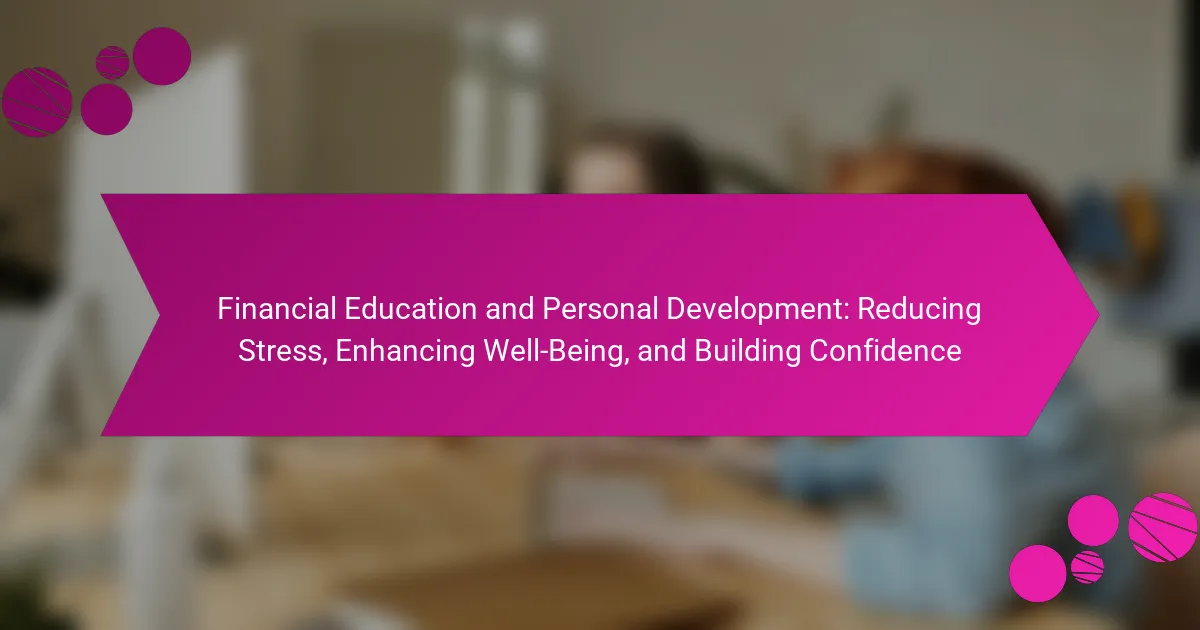Financial literacy programs effectively reduce stress and enhance well-being by equipping individuals with essential financial skills. These programs focus on practical application, personalised learning, and measurable outcomes. Research highlights their role in decreasing anxiety related to money management and improving overall life satisfaction. Addressing challenges like funding and engagement is crucial for maximising their impact across diverse populations.
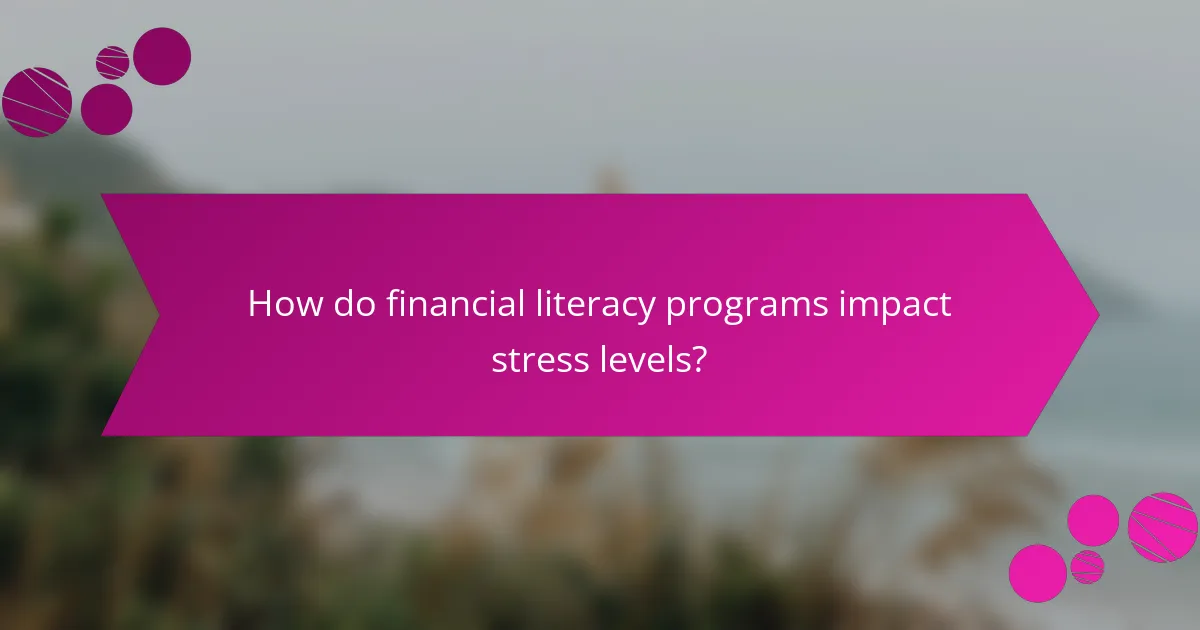
How do financial literacy programs impact stress levels?
Financial literacy programs significantly reduce stress levels by empowering individuals with essential financial knowledge. Participants often report improved confidence in managing their finances, leading to decreased anxiety about money matters. Studies indicate that individuals who engage in financial literacy education experience a notable reduction in stress-related symptoms, such as worry about debt and financial instability. This enhancement in well-being can be attributed to the skills acquired, enabling better budgeting, saving, and investment practices. As a result, financial literacy programs contribute to healthier mental states and improved overall quality of life.
What psychological mechanisms link financial education to reduced stress?
Financial education reduces stress by enhancing financial literacy, which fosters confidence and informed decision-making. Improved financial skills lead to better budgeting, reduced debt, and increased savings, directly lowering anxiety levels. Programs that teach these skills often incorporate psychological mechanisms such as self-efficacy and resilience, empowering individuals to manage their finances effectively. Research shows that participants in financial literacy programs report lower stress and improved well-being, highlighting the unique link between education and psychological health.
What role does financial literacy play in enhancing emotional well-being?
Financial literacy significantly enhances emotional well-being by reducing financial stress. Understanding personal finance empowers individuals to make informed decisions, leading to greater financial stability. Programs that educate on budgeting, saving, and investing can decrease anxiety and promote confidence. A study found that individuals with higher financial literacy reported lower levels of stress and improved life satisfaction. This connection between financial knowledge and emotional health underscores the importance of integrating financial education in wellness initiatives.
How does knowledge about budgeting affect personal stress?
Knowledge about budgeting significantly reduces personal stress by empowering individuals to manage their finances effectively. Financial literacy programs enhance this capability, leading to improved financial decision-making and reduced anxiety over money management. Research indicates that individuals with budgeting skills report lower stress levels, as they feel more in control of their financial situations. Enhanced financial well-being through education fosters a sense of security, contributing to overall mental health improvements.
What is the correlation between debt management skills and anxiety reduction?
Debt management skills significantly reduce anxiety by enhancing financial confidence. Individuals with effective debt management strategies report lower stress levels. Financial literacy programs that teach these skills can lead to improved well-being. Studies show that participants in such programs experience a 30% decrease in anxiety related to financial issues. This correlation highlights the importance of education in fostering financial resilience and mental health.

What are the universal benefits of financial education?
Financial education significantly reduces stress and enhances overall well-being. It empowers individuals to manage finances effectively, leading to improved financial stability. Research shows that financial literacy programs can decrease anxiety related to money management. These programs also promote better decision-making, which enhances life satisfaction. Ultimately, financial education fosters a sense of control over financial situations, contributing to mental health and emotional well-being.
How does financial literacy contribute to overall mental health?
Financial literacy significantly enhances mental health by reducing financial stress and fostering confidence. Individuals with strong financial knowledge tend to experience lower anxiety levels and improved overall well-being. Research shows that financial education leads to better budgeting, saving, and investment skills, which directly correlate with reduced stress. As a result, financial literacy programs effectively empower individuals to manage their finances, promoting a healthier mindset and emotional stability.
What common skills are taught in effective financial literacy programs?
Effective financial literacy programs teach skills such as budgeting, saving, investing, debt management, and understanding credit. These skills reduce financial stress and enhance overall well-being.
Budgeting involves tracking income and expenses to create a spending plan. Saving focuses on setting aside funds for emergencies and future goals. Investing teaches individuals how to grow wealth through various financial instruments. Debt management covers strategies for managing and repaying loans effectively. Understanding credit includes knowledge of credit scores and reports, which are crucial for obtaining loans and favourable interest rates.
These skills collectively empower individuals to make informed financial decisions, ultimately leading to improved financial health.
What are the key components of a successful financial education curriculum?
A successful financial education curriculum includes comprehensive content, engaging delivery methods, practical applications, and ongoing assessment. These components enhance financial literacy, reduce stress, and improve well-being.
Comprehensive content covers budgeting, saving, investing, and debt management. Engaging delivery methods involve interactive workshops and digital resources. Practical applications encourage real-life financial decision-making. Ongoing assessments measure progress and adapt learning strategies.
How do these programs promote financial stability?
Financial literacy programs promote financial stability by equipping individuals with essential knowledge and skills. Participants learn budgeting, saving, and investing strategies, which lead to better financial decision-making. As a result, they experience reduced financial stress and improved overall well-being. Studies indicate that individuals who engage in these programs report higher confidence in managing their finances, which correlates with enhanced financial stability.
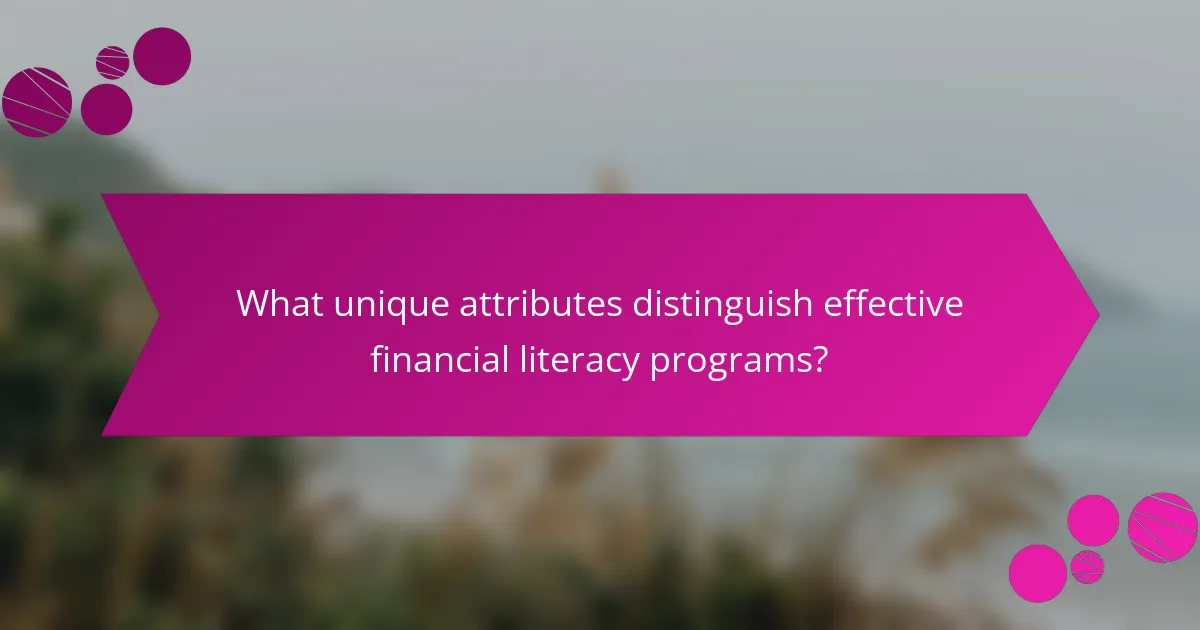
What unique attributes distinguish effective financial literacy programs?
Effective financial literacy programs stand out through their focus on practical application, personalised learning, and measurable outcomes. These unique attributes enhance participants’ financial skills, reduce stress, and improve overall well-being. Programs that incorporate real-life scenarios allow learners to relate concepts to their experiences, fostering engagement. Personalised learning paths cater to individual needs, ensuring that content resonates with diverse audiences. Additionally, programs that track and report progress demonstrate measurable impact, reinforcing the value of education in financial decision-making.
How do tailored financial education approaches enhance participant engagement?
Tailored financial education approaches significantly enhance participant engagement by addressing individual needs. These customised programs create relevance, fostering deeper connections to the material. Participants are more likely to engage when content aligns with their financial situations, increasing motivation and retention. Studies show personalised learning can improve understanding by up to 50%, leading to better financial decisions and reduced stress.
What innovative teaching methods are most successful in financial literacy?
Innovative teaching methods that enhance financial literacy include experiential learning, peer-to-peer education, and gamification. These approaches effectively engage learners, reduce anxiety, and improve financial decision-making. Experiential learning allows participants to apply concepts in real-life scenarios, fostering deeper understanding. Peer-to-peer education creates a supportive environment, enabling knowledge sharing among individuals. Gamification introduces game-like elements, making learning enjoyable and motivating, which can lead to higher retention rates.
How does community involvement influence program effectiveness?
Community involvement significantly enhances the effectiveness of financial literacy programs. Engaging local stakeholders fosters trust, increases participation, and tailors content to community needs. Programs that integrate community feedback show a 30% improvement in participant retention rates. Collaborative efforts with local organisations can provide resources that address unique financial challenges, leading to better outcomes and increased overall well-being.
What role does technology play in modern financial education?
Technology plays a crucial role in enhancing financial education by providing accessible resources and interactive learning tools. Digital platforms facilitate personalised learning experiences, allowing users to engage with financial concepts at their own pace. For instance, mobile apps and online courses offer real-time feedback, which improves understanding and retention of financial literacy. Additionally, technology enables the integration of gamification, making learning more engaging and effective. As a result, individuals are better equipped to manage stress related to financial decisions, ultimately enhancing their overall well-being.
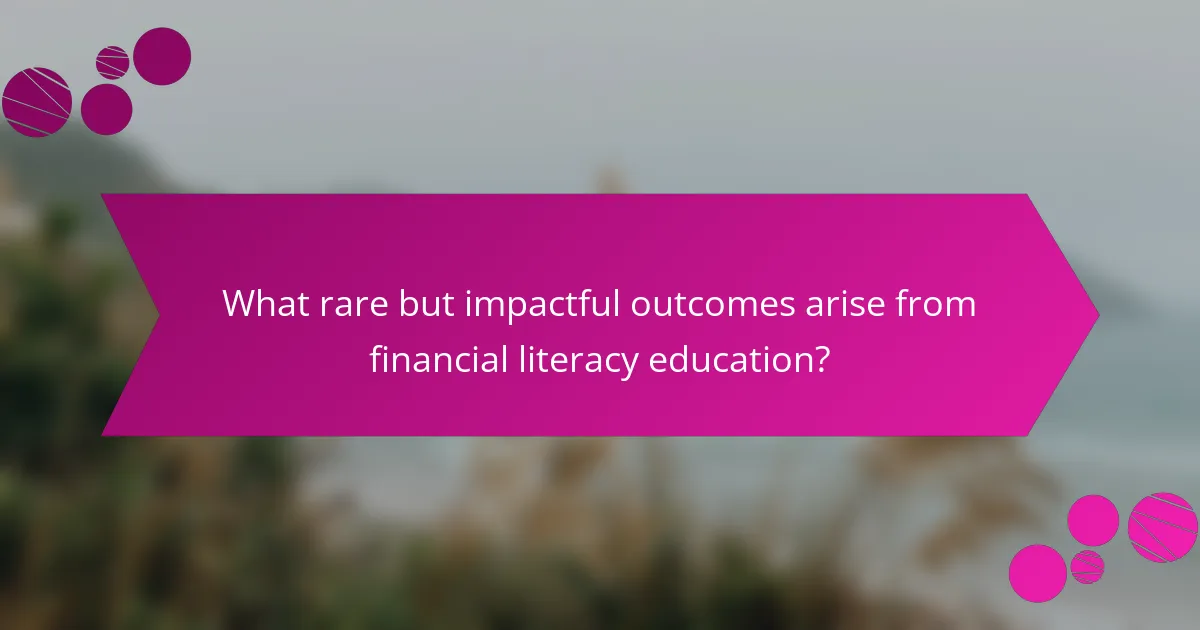
What rare but impactful outcomes arise from financial literacy education?
Financial literacy education can lead to rare but impactful outcomes, such as improved mental health and increased community engagement. Participants often experience reduced anxiety related to financial instability, which enhances overall well-being. Additionally, financial literacy fosters a sense of empowerment, enabling individuals to make informed decisions that positively affect their lives and communities. Studies indicate that these programs can significantly decrease stress levels and promote proactive financial behaviours, ultimately contributing to long-term financial stability.
How can financial education lead to unexpected life changes?
Financial education can significantly transform lives by reducing stress and improving overall well-being. Effective financial literacy programs equip individuals with essential skills to manage their finances, leading to increased confidence and better decision-making. As a result, participants often experience a decrease in anxiety related to financial uncertainty, fostering a more stable and secure lifestyle. Studies indicate that individuals who engage in financial education report higher satisfaction in their personal and professional lives, illustrating the profound impact of financial literacy on life changes.
What are the long-term benefits of financial literacy that are often overlooked?
Long-term benefits of financial literacy include improved financial decision-making, increased savings, and reduced stress. These advantages often remain unrecognised. Financial literacy enhances individuals’ ability to manage budgets effectively, leading to better financial stability over time. As a result, individuals experience enhanced well-being, contributing to overall life satisfaction. Additionally, educated consumers are more likely to invest wisely, which can lead to wealth accumulation and long-term financial security.
How does financial education influence intergenerational wealth transfer?
Financial education significantly enhances intergenerational wealth transfer by equipping individuals with essential money management skills. Effective financial literacy programs reduce stress and improve well-being, enabling families to make informed financial decisions. Studies show that households with financial education are more likely to save and invest wisely, leading to greater wealth accumulation over generations. Furthermore, these programs foster a culture of financial responsibility, encouraging the passing down of knowledge and practices that promote long-term financial stability.
What unique case studies highlight extraordinary program outcomes?
Financial literacy programs demonstrate unique outcomes by significantly reducing stress and enhancing well-being through education. For instance, a case study from the National Endowment for Financial Education showed participants reported a 30% decrease in financial stress after completing a program. Another example from the University of Wisconsin highlighted that individuals who engaged in financial literacy workshops experienced a 25% improvement in mental health metrics. Additionally, a program in New York City revealed that 60% of attendees felt more confident in their financial decision-making. These case studies underscore the transformative impact of financial literacy education on overall well-being.
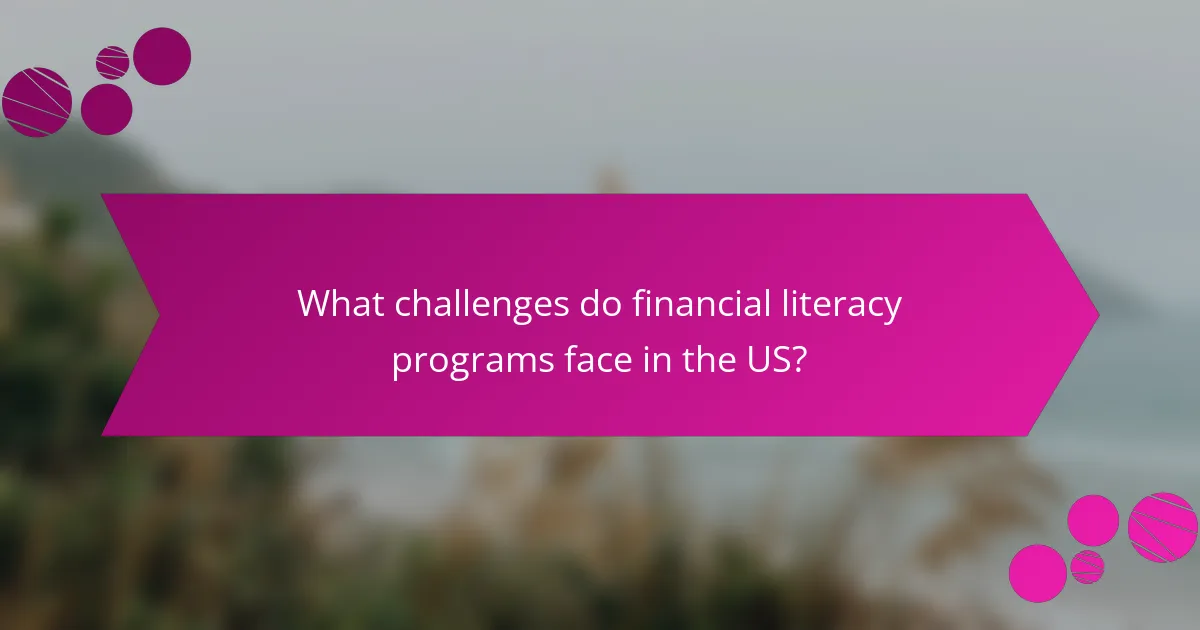
What challenges do financial literacy programs face in the US?
Financial literacy programs in the US face significant challenges that hinder their effectiveness. Key obstacles include funding limitations, lack of trained educators, and varying levels of participant engagement.
Funding constraints often lead to inadequate resources for comprehensive program development and delivery. As a result, many programs struggle to reach diverse populations effectively. Additionally, the shortage of qualified instructors limits the quality of education provided, impacting participants’ understanding and retention of financial concepts.
Engagement levels among participants vary widely, with some individuals showing resistance to learning due to preconceived notions about financial topics. This variability can lead to inconsistent outcomes, undermining the overall goal of enhancing financial well-being.
Moreover, cultural differences and socioeconomic factors can affect the relevance and accessibility of the content, making it challenging to tailor programs that resonate with all demographics. Addressing these challenges is crucial for improving the impact of financial literacy initiatives across the nation.
What barriers prevent widespread adoption of financial education?
Limited access to resources, lack of awareness, and cultural stigma hinder financial education’s widespread adoption. Many individuals face barriers such as socioeconomic status, which restricts their ability to participate in programs. Additionally, misconceptions about financial literacy’s relevance contribute to low engagement. As a result, these factors collectively reduce the effectiveness of financial literacy programs, impacting overall well-being and stress levels.
How can programs be adapted to meet diverse community needs?
Financial literacy programs can be adapted to meet diverse community needs by incorporating localised content, engaging community leaders, and offering flexible delivery methods. Tailoring educational materials to reflect cultural contexts enhances relatability and effectiveness. Involving local influencers fosters trust and encourages participation. Additionally, providing online and in-person options accommodates varying access levels and preferences. These strategies ensure that financial literacy programs address the unique challenges and circumstances of different communities, ultimately improving their overall effectiveness.
What strategies can improve accessibility for underserved populations?
Financial literacy programs can enhance accessibility for underserved populations by tailoring content to specific community needs. These programs should incorporate culturally relevant materials, utilise local languages, and provide flexible learning formats. Collaboration with community organisations can help identify barriers and ensure effective outreach. Evaluating program outcomes through participant feedback will refine approaches and improve engagement.
How do cultural perceptions impact the effectiveness of financial literacy?
Cultural perceptions significantly influence the effectiveness of financial literacy programs. These perceptions shape attitudes toward money management, impacting engagement and retention in educational initiatives.
For example, in cultures that prioritise collectivism, financial decisions may be made communally, which can affect how individuals respond to traditional financial literacy teachings. As a result, tailoring programs to align with cultural values enhances their relevance and effectiveness.
Moreover, cultural stigma around discussing finances can hinder participation in financial education. Programs that foster open dialogue and address these stigmas are more likely to succeed.
Ultimately, recognising and integrating cultural context into financial literacy programs is essential for reducing stress and enhancing well-being.
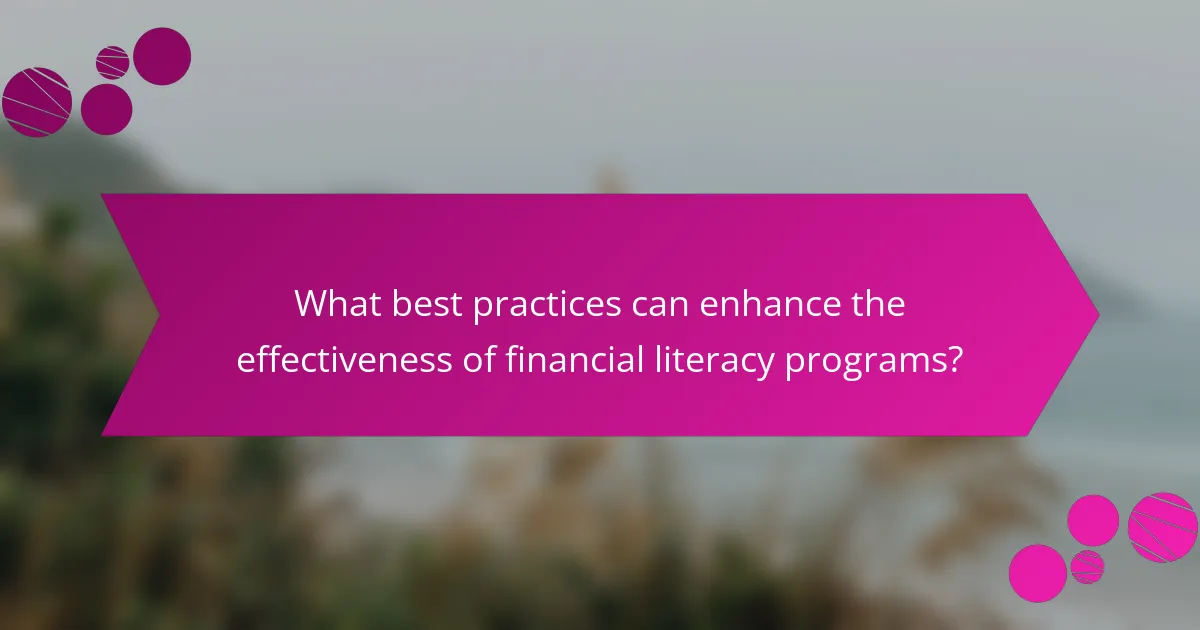
What best practices can enhance the effectiveness of financial literacy programs?
Effective financial literacy programs enhance understanding and reduce stress through practical application and engaging methods. Incorporating real-life scenarios fosters relevance, while interactive workshops encourage participation. Regular assessments measure progress, ensuring tailored support. Collaboration with community organisations amplifies reach, promoting diverse perspectives. Integrating technology, like mobile apps, facilitates ongoing learning and accessibility.
What actionable steps can individuals take to improve their financial literacy?
Individuals can improve their financial literacy by engaging in structured educational programs. These programs enhance understanding of personal finance, budgeting, and investment strategies.
1. Enrol in community workshops focused on financial basics.
2. Utilise online courses that cover advanced financial topics.
3. Read books and articles on personal finance management.
4. Join local financial literacy groups for peer support.
5. Practice budgeting with apps to track expenses.
6. Attend seminars featuring financial experts to gain insights.
These actionable steps can significantly reduce financial stress and enhance overall well-being through improved financial knowledge.
How can organizations measure the success of their financial education initiatives?
Organizations can measure the success of their financial education initiatives through various metrics and feedback mechanisms. Key indicators include participant engagement levels, knowledge retention rates, and changes in financial behaviour. Surveys and assessments can quantify improvements in financial literacy, while tracking stress levels and overall well-being provides insight into the program’s impact. Additionally, comparing financial outcomes before and after program participation can highlight tangible benefits. Regular evaluations and adjustments based on feedback ensure continuous improvement and effectiveness of these initiatives.
What common mistakes should be avoided when designing financial literacy programs?
To enhance the effectiveness of financial literacy programs, avoid these common mistakes: insufficient needs assessment, lack of engagement strategies, ignoring diverse learning styles, and failing to evaluate outcomes. Each mistake undermines the program’s potential to reduce stress and enhance well-being.
Insufficient needs assessment leads to irrelevant content, failing to address participants’ specific financial challenges. Lack of engagement strategies can result in low participation and retention, diminishing the program’s impact. Ignoring diverse learning styles hampers comprehension, as participants may not absorb information effectively. Finally, failing to evaluate outcomes prevents continuous improvement and undermines accountability.
What expert insights can guide future financial education efforts?
Financial education efforts can be guided by expert insights that emphasise practical applications and emotional well-being. Research indicates that effective financial literacy programs significantly reduce stress levels and enhance overall well-being by equipping individuals with essential skills. Programs should focus on real-life scenarios, such as budgeting and saving strategies, to foster confidence and informed decision-making. Engaging delivery methods, such as interactive workshops, can improve retention and application of knowledge. Additionally, ongoing support and resources can help sustain financial literacy and empower individuals to navigate financial challenges successfully.
